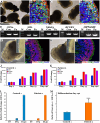Demonstration of the pathogenicity of a common non-exomic mutation in ABCA4 using iPSC-derived retinal organoids and retrospective clinical data
- PMID: 37930186
- PMCID: PMC11305681
- DOI: 10.1093/hmg/ddad176
Demonstration of the pathogenicity of a common non-exomic mutation in ABCA4 using iPSC-derived retinal organoids and retrospective clinical data
Abstract
Mutations in ABCA4 are the most common cause of Mendelian retinal disease. Clinical evaluation of this gene is challenging because of its extreme allelic diversity, the large fraction of non-exomic mutations, and the wide range of associated disease. We used patient-derived retinal organoids as well as DNA samples and clinical data from a large cohort of patients with ABCA4-associated retinal disease to investigate the pathogenicity of a variant in ABCA4 (IVS30 + 1321 A>G) that occurs heterozygously in 2% of Europeans. We found that this variant causes mis-splicing of the gene in photoreceptor cells such that the resulting protein contains 36 incorrect amino acids followed by a premature stop. We also investigated the phenotype of 10 patients with compound genotypes that included this mutation. Their median age of first vision loss was 39 years, which is in the mildest quintile of a large cohort of patients with ABCA4 disease. We conclude that the IVS30 + 1321 A>G variant can cause disease when paired with a sufficiently deleterious opposing allele in a sufficiently permissive genetic background.
Keywords: ABCA4; RNA splicing; Stargardt disease; genetic testing; retinal organoids.
© The Author(s) 2023. Published by Oxford University Press. All rights reserved. For Permissions, please email: journals.permissions@oup.com.
Figures





References
-
- Weng J, Mata NL, Azarian SM. et al. Insights into the function of Rim protein in photoreceptors and etiology of Stargardt's disease from the phenotype in abcr knockout mice. Cell 1999;98:13–23. - PubMed
-
- Webster AR, Heon E, Lotery AJ. et al. An analysis of allelic variation in the ABCA4 gene. Invest Ophthalmol Vis Sci 2001;42:1179–89. - PubMed
Publication types
MeSH terms
Substances
Grants and funding
LinkOut - more resources
Full Text Sources

